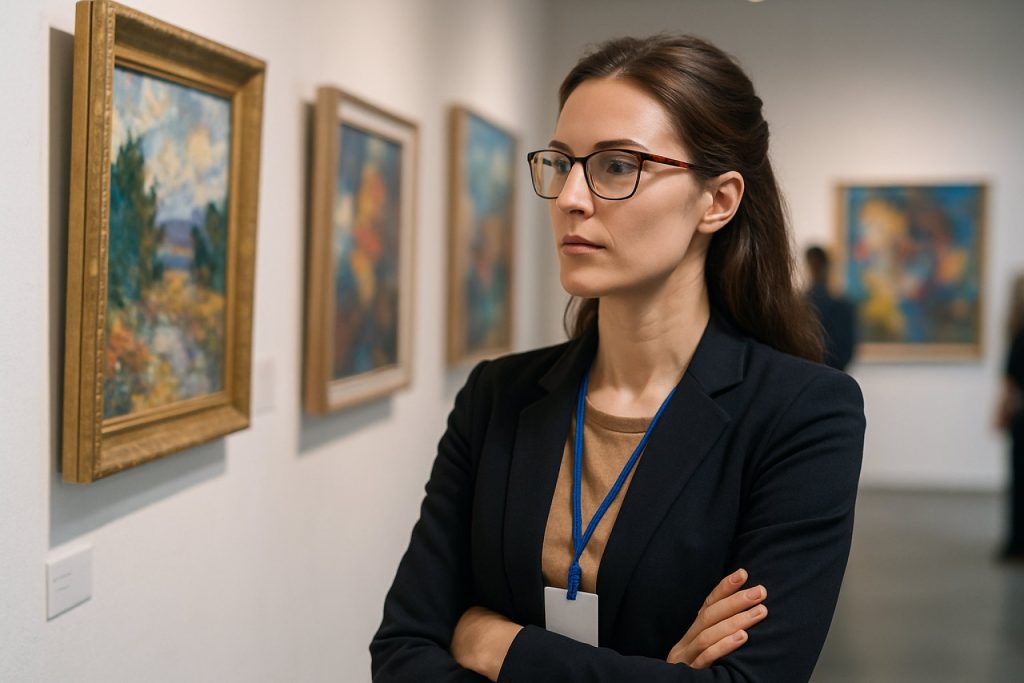
Inside Juried Art Exhibitions: How Selection, Prestige, and Competition Shape the Art World. Discover What Sets These Events Apart for Artists and Audiences Alike.
- The Origins and Evolution of Juried Art Exhibitions
- How the Jury Process Works: Selection Criteria and Methods
- Key Benefits for Participating Artists
- Challenges and Controversies in Juried Shows
- Impact on Artistic Careers and Market Value
- Notable Juried Exhibitions Worldwide
- Digital Transformation: Online Juried Art Shows
- Diversity, Inclusion, and Representation in Jury Panels
- Tips for Artists: Preparing a Winning Submission
- Future Trends in Juried Art Exhibitions
- Sources & References
The Origins and Evolution of Juried Art Exhibitions
Juried art exhibitions have a rich and complex history, reflecting broader developments in the art world and society at large. The concept of a juried exhibition—where submitted artworks are evaluated and selected by a panel of experts—can be traced back to the formalized art academies of Europe in the 17th and 18th centuries. One of the earliest and most influential examples is the Salon, established by the Académie des Beaux-Arts in Paris. The Salon became the official art exhibition of the French Academy, and its juried selection process set a precedent for artistic standards and public taste. Artists submitted their works to be judged by academic members, and acceptance into the Salon was often crucial for an artist’s reputation and career.
As the model spread, other countries established their own academies and juried exhibitions, such as the Royal Academy of Arts in London, founded in 1768. The Royal Academy of Arts continues to host its annual Summer Exhibition, which is the world’s longest-running open submission exhibition. These early juried shows were often conservative, reinforcing academic traditions and excluding avant-garde or non-traditional works. However, the system also provided a platform for emerging artists and fostered public engagement with the visual arts.
The 19th and 20th centuries saw significant evolution in the structure and purpose of juried exhibitions. The rise of independent salons, such as the Salon des Refusés in 1863, challenged the authority of academic juries and opened the door to new artistic movements. In the United States, juried exhibitions became a key feature of museums and art societies, with organizations like the Metropolitan Museum of Art and the National Gallery of Art occasionally hosting juried shows to highlight contemporary talent.
Today, juried art exhibitions are a global phenomenon, ranging from prestigious biennials and museum shows to local and online competitions. The jury process has diversified, often including curators, critics, artists, and even public voting. This evolution reflects a broader democratization of the art world, allowing for greater diversity in artistic expression and participation. Despite changes in format and technology, the core principle remains: juried exhibitions serve as a vital mechanism for recognizing artistic achievement, fostering dialogue, and shaping the trajectory of contemporary art.
How the Jury Process Works: Selection Criteria and Methods
The jury process is central to the integrity and reputation of juried art exhibitions. It is designed to ensure that artworks are evaluated fairly and according to established standards, with the goal of assembling a high-quality, cohesive exhibition. The process typically begins with an open call for submissions, where artists submit digital images, statements, and other required materials. Once submissions are received, a panel of jurors—often composed of curators, established artists, art historians, or other art professionals—is convened to review the entries.
Selection criteria can vary depending on the exhibition’s theme, medium, or institutional mission, but generally include artistic merit, originality, technical skill, and relevance to the exhibition’s concept. Jurors may also consider factors such as innovation, craftsmanship, and the artist’s ability to communicate ideas visually. For example, the National Academy of Design, a leading American institution, emphasizes both technical proficiency and conceptual depth in its juried exhibitions, seeking works that demonstrate a high level of achievement and contribute meaningfully to contemporary discourse.
The methods used by juries can range from in-person deliberations to digital review platforms. In many cases, the initial round of judging is conducted anonymously, with jurors viewing artworks without knowledge of the artists’ identities to minimize bias. This “blind” review process is a standard practice in major exhibitions, such as those organized by the Smithsonian Institution, which regularly hosts juried shows and outlines transparent selection procedures to ensure fairness and diversity. After the initial review, jurors may meet to discuss shortlisted works, sometimes requesting to see physical pieces or additional documentation before making final selections.
Transparency and accountability are increasingly important in the jury process. Many organizations, including the National Gallery of Art, publish their selection criteria and jury composition to foster trust among artists and audiences. Some exhibitions also provide feedback to applicants, helping artists understand the strengths and weaknesses of their submissions. Ultimately, the jury process is designed to balance subjective judgment with objective standards, ensuring that selected works reflect both individual excellence and the broader goals of the exhibition.
Key Benefits for Participating Artists
Participating in juried art exhibitions offers a range of significant benefits for artists at various stages of their careers. One of the primary advantages is the opportunity for professional recognition. Being selected by a panel of expert jurors—often composed of established artists, curators, and art professionals—serves as a mark of quality and can enhance an artist’s reputation within the art community. This recognition can be a valuable addition to an artist’s curriculum vitae and portfolio, signaling to galleries, collectors, and institutions that their work meets a high standard of excellence.
Juried exhibitions also provide artists with increased visibility. These events are typically promoted by the organizing institutions, which may include museums, art centers, or professional associations. For example, organizations such as the National Gallery of Art and the Smithsonian Institution regularly host or support juried exhibitions, offering artists exposure to a broad audience of art enthusiasts, critics, and potential buyers. This visibility can lead to further exhibition opportunities, gallery representation, and sales.
Another key benefit is the opportunity for critical feedback. Juried exhibitions often include written or verbal critiques from jurors, providing artists with constructive insights into their work. This feedback can be instrumental in helping artists refine their practice, develop new ideas, and understand how their work is perceived in a professional context.
Networking is another important aspect of participating in juried exhibitions. These events bring together artists, curators, collectors, and other art professionals, creating opportunities for collaboration and professional growth. Artists may form connections that lead to future projects, mentorship, or inclusion in other exhibitions. Organizations such as the Artists Network and the National Artists Register facilitate such networking opportunities through their juried events and online platforms.
Finally, juried exhibitions can provide financial benefits. Many offer cash prizes, grants, or the possibility of selling artwork during the exhibition. Some institutions also acquire works for their permanent collections, offering artists both financial compensation and the prestige of institutional recognition. Overall, participation in juried art exhibitions can be a pivotal step in an artist’s professional development, offering recognition, exposure, feedback, networking, and financial rewards.
Challenges and Controversies in Juried Shows
Juried art exhibitions, while central to the art world’s ecosystem, are not without their challenges and controversies. One of the most persistent issues is the question of bias in the selection process. Jurors, often established artists, curators, or art professionals, bring their own tastes, backgrounds, and networks to the table. This can inadvertently favor certain artistic styles, mediums, or even demographics, leading to concerns about inclusivity and representation. For example, some artists and critics argue that traditional juried shows may underrepresent emerging artists, artists from marginalized communities, or those working in non-traditional media.
Transparency is another significant challenge. Many exhibitions do not disclose detailed criteria or feedback regarding selection decisions, leaving applicants uncertain about why their work was or was not chosen. This opacity can foster perceptions of favoritism or lack of accountability. In response, some organizations have begun to publish juror statements or offer feedback sessions, but such practices are not yet universal.
The cost of entry is also a point of contention. Many juried exhibitions require submission fees, which can be prohibitive for some artists, particularly those early in their careers or from under-resourced backgrounds. While these fees often help cover administrative costs, they can create barriers to participation and reinforce existing inequities within the art world. Some organizations, such as the New York Foundation for the Arts, advocate for more accessible models, including fee waivers or sliding scales, to broaden participation.
Another controversy involves the potential for conflicts of interest. Jurors may have prior relationships with applicants or be involved in galleries that represent certain artists, raising questions about impartiality. Leading organizations, such as the National Endowment for the Arts, have established conflict-of-interest policies and guidelines to mitigate these risks, but enforcement and transparency vary widely across institutions.
Finally, the very concept of “quality” in art is subjective, and juried exhibitions can sometimes reinforce prevailing trends at the expense of innovation. Critics argue that the competitive nature of these shows may discourage risk-taking or experimental work, as artists tailor submissions to perceived juror preferences. As the art world continues to evolve, many institutions are re-examining their processes to foster greater diversity, equity, and openness in juried exhibitions.
Impact on Artistic Careers and Market Value
Juried art exhibitions play a significant role in shaping the careers of artists and influencing the market value of their work. These exhibitions, which involve a selection process overseen by a panel of experts or established artists, serve as a critical platform for both emerging and established creators to gain recognition, build professional networks, and enhance their reputations within the art world.
One of the primary impacts of participating in juried exhibitions is the validation and credibility conferred by selection. Being chosen by a respected jury signals to collectors, galleries, and institutions that an artist’s work meets high standards of quality and innovation. This endorsement can lead to increased opportunities, such as invitations to participate in other prestigious exhibitions, gallery representation, and even acquisition by museums or public collections. For example, organizations like the National Academy of Design and the Smithsonian Institution regularly host juried exhibitions that have historically launched or accelerated the careers of numerous artists.
The exposure gained through juried exhibitions is another crucial factor. These events often attract curators, critics, and collectors, providing artists with a platform to reach new audiences. The visibility can result in media coverage, critical reviews, and increased demand for the artist’s work. In some cases, awards or prizes associated with juried exhibitions further enhance an artist’s profile and can be highlighted in resumes and portfolios, adding to their professional credentials.
Market value is also directly affected by participation in juried exhibitions. Works that have been selected for or have won awards in such exhibitions often command higher prices in the art market. The association with reputable institutions or jurors can increase buyer confidence and perceived investment value. For instance, the Saatchi Art platform, which organizes juried competitions and exhibitions, notes that artists who have participated in these events often see a measurable increase in sales and commissions.
Furthermore, juried exhibitions foster professional development by encouraging artists to refine their practice and engage with critical feedback. The competitive nature of the selection process motivates artists to present their best work, while feedback from jurors can provide valuable insights for artistic growth. In summary, juried art exhibitions serve as a vital mechanism for career advancement and market validation, offering artists both recognition and tangible economic benefits.
Notable Juried Exhibitions Worldwide
Juried art exhibitions are a cornerstone of the global art ecosystem, providing artists with opportunities for recognition, exposure, and career advancement. These exhibitions are distinguished by their selection process, in which a panel of experts—often curators, established artists, or critics—reviews submissions and selects works based on merit, originality, and relevance. Around the world, several juried exhibitions have gained prominence for their rigorous standards and significant impact on the art community.
One of the most prestigious is the Venice Biennale, established in 1895 and held every two years in Venice, Italy. The Biennale is renowned for its international scope, featuring national pavilions and curated exhibitions that set trends in contemporary art. Its juried awards, such as the Golden Lion, are highly coveted and can launch or solidify an artist’s international reputation. The La Biennale di Venezia is organized by the official foundation of the same name, which oversees not only the art exhibition but also events in architecture, cinema, dance, music, and theatre.
In the United States, the Whitney Biennial, organized by the Whitney Museum of American Art in New York, is a leading showcase for contemporary American artists. Since its inception in 1932, the Whitney Biennial has played a pivotal role in identifying emerging trends and artists, with a rigorous selection process conducted by invited curators. The exhibition is widely regarded as a barometer of the American art scene.
The Royal Academy of Arts in London hosts the Summer Exhibition, the world’s longest-running open submission exhibition, dating back to 1769. The Royal Academy of Arts invites artists from all backgrounds to submit works, which are then juried by a committee of Royal Academicians. The exhibition is notable for its inclusivity and for providing a platform for both established and emerging artists.
Other significant juried exhibitions include the International Biennial of Contemporary Art of São Paulo, organized by the Fundação Bienal de São Paulo, and the Sharjah Biennial, overseen by the Sharjah Art Foundation in the United Arab Emirates. Both events are recognized for their commitment to showcasing diverse artistic voices and fostering cross-cultural dialogue.
These notable juried exhibitions not only elevate individual artists but also shape the discourse and direction of contemporary art on a global scale, reflecting the evolving priorities and aesthetics of the art world.
Digital Transformation: Online Juried Art Shows
The digital transformation of juried art exhibitions has significantly expanded the reach and accessibility of these events. Traditionally, juried art shows required physical submissions and in-person attendance, often limiting participation to artists within a certain geographic area. With the advent of online platforms, the process has become more inclusive, allowing artists from around the world to submit their work digitally for consideration by juries. This shift has been accelerated by technological advancements and the necessity for remote engagement, particularly during global events such as the COVID-19 pandemic.
Online juried art exhibitions typically involve artists uploading high-resolution images or videos of their work to a dedicated platform. Jurors, who are often established artists, curators, or art professionals, review submissions remotely and select works for inclusion in the virtual exhibition. This process not only streamlines logistics but also reduces costs associated with shipping, insurance, and venue rental. As a result, more artists can participate, and organizations can curate a more diverse and representative selection of artworks.
Major art organizations have embraced digital transformation to maintain and even expand their programming. For example, the Smithsonian Institution has hosted online exhibitions and juried competitions, leveraging its digital infrastructure to reach global audiences. Similarly, the National Arts Club and the Saatchi Art platform have developed robust online juried shows, providing artists with new opportunities for exposure and recognition. These organizations often use secure, purpose-built submission portals and virtual gallery spaces to ensure a professional and engaging experience for both artists and viewers.
The digital format also introduces new curatorial possibilities. Virtual exhibitions can incorporate multimedia elements, interactive features, and detailed artist statements, enhancing the viewer’s experience and understanding of the work. Additionally, online juried shows can remain accessible for longer periods, allowing for extended public engagement and the potential for broader critical discourse. Some platforms, such as Saatchi Art, also facilitate direct sales, connecting artists with collectors worldwide.
Despite these advantages, digital juried exhibitions present challenges, including concerns about image fidelity, digital security, and the absence of physical interaction with the artwork. Nevertheless, the ongoing evolution of technology and the growing acceptance of online formats suggest that digital juried art exhibitions will remain a vital component of the contemporary art landscape, complementing traditional in-person shows and expanding opportunities for artists and audiences alike.
Diversity, Inclusion, and Representation in Jury Panels
Diversity, inclusion, and representation within jury panels are increasingly recognized as essential components of equitable juried art exhibitions. The composition of a jury directly influences which artists and artworks are selected, shaping the narratives and perspectives presented to the public. Historically, many art institutions and exhibitions have faced criticism for a lack of diversity among jurors, which can perpetuate biases and limit opportunities for underrepresented artists. In response, leading organizations and museums have begun to prioritize more inclusive jury selection processes.
A diverse jury panel typically encompasses a range of backgrounds, including differences in race, ethnicity, gender, age, geographic location, and artistic discipline. This diversity helps ensure that a broader spectrum of artistic voices and cultural experiences are recognized and valued. For example, the National Gallery of Art in the United States and the Tate in the United Kingdom have both made public commitments to increasing diversity and inclusion within their governance and curatorial teams, which often extend to the selection of jurors for exhibitions and awards.
Inclusion goes beyond mere representation; it involves creating an environment where all jurors feel empowered to contribute their perspectives. This can be facilitated through training on unconscious bias, transparent selection criteria, and open dialogue among panel members. Organizations such as the Arts Council England have published guidelines and best practices for inclusive decision-making in the arts, emphasizing the importance of fair and accessible processes for both jurors and artists.
Representation on jury panels also has a direct impact on the diversity of artists who are selected for exhibitions. Studies and reports from bodies like the National Endowment for the Arts indicate that when juries are more representative of the broader community, the resulting exhibitions tend to feature a wider array of artistic styles, cultural narratives, and emerging voices. This not only benefits artists from marginalized backgrounds but also enriches the cultural landscape for audiences.
In summary, fostering diversity, inclusion, and representation in jury panels is a critical step toward ensuring that juried art exhibitions reflect the full spectrum of artistic talent and cultural experience. As more institutions adopt these principles, the art world moves closer to a more equitable and dynamic future.
Tips for Artists: Preparing a Winning Submission
Preparing a winning submission for a juried art exhibition requires a strategic approach that goes beyond simply selecting your best work. Artists must consider how their portfolio aligns with the exhibition’s theme, the expectations of the jury, and the technical requirements of the application process. Here are key tips to help artists maximize their chances of success:
- Understand the Exhibition’s Theme and Criteria: Carefully review the exhibition’s prospectus and guidelines. Juried exhibitions, such as those organized by the National Academy of Design or the Smithsonian Institution, often have specific themes, eligibility requirements, and submission formats. Tailoring your submission to these parameters demonstrates professionalism and respect for the curatorial vision.
- Select Cohesive and Relevant Works: Choose pieces that not only showcase your technical skill but also form a coherent narrative or visual language. Jurors often look for consistency and a clear artistic voice. Avoid including works that do not fit the exhibition’s focus, even if they are strong individually.
- Present High-Quality Images: Most juried exhibitions require digital submissions. Ensure your images are well-lit, in focus, and accurately represent the artwork’s colors and textures. Organizations like the National Gallery of Art recommend using neutral backgrounds and avoiding distractions in the frame. Follow the specified file formats and size requirements exactly.
- Craft a Compelling Artist Statement: A concise, thoughtful artist statement contextualizes your work and helps jurors understand your intent. Focus on your creative process, conceptual framework, and how your work relates to the exhibition’s theme. Avoid jargon and keep the language accessible.
- Double-Check Submission Details: Incomplete or incorrectly formatted applications are often disqualified. Before submitting, verify that all required materials—such as images, statements, and entry fees—are included and meet the guidelines. Many organizations, including the Artists Network, provide checklists or FAQs to assist applicants.
- Meet Deadlines and Plan Ahead: Submit your application well before the deadline to avoid technical issues or last-minute errors. Early submissions also allow time for troubleshooting and demonstrate your commitment to the process.
By approaching the submission process with attention to detail and a clear understanding of the exhibition’s goals, artists can significantly improve their chances of being selected for juried art exhibitions.
Future Trends in Juried Art Exhibitions
The landscape of juried art exhibitions is evolving rapidly, shaped by technological advancements, shifting cultural priorities, and the increasing globalization of the art world. One of the most significant trends is the integration of digital platforms into the submission and selection processes. Many established organizations, such as Smithsonian Institution and The National Arts Club, have adopted online portals for artists to submit their works, making participation more accessible to a global pool of artists. This digital shift not only streamlines logistics but also democratizes access, allowing emerging artists from diverse backgrounds to compete on a more level playing field.
Another emerging trend is the hybridization of exhibitions, where physical gallery shows are complemented by virtual tours and online showcases. Institutions like the The Metropolitan Museum of Art have pioneered virtual exhibition spaces, enabling broader audience engagement and providing new opportunities for artists to gain international exposure. This hybrid model is likely to become a standard, as it addresses both the limitations of physical space and the growing demand for digital content.
Sustainability and social responsibility are also becoming central to the future of juried art exhibitions. Many organizations are re-evaluating their practices to reduce environmental impact, such as encouraging digital submissions, minimizing shipping, and utilizing eco-friendly materials for installations. Additionally, there is a growing emphasis on inclusivity and representation, with juried exhibitions increasingly prioritizing works from underrepresented groups and addressing contemporary social issues. For example, the National Gallery of Art has launched initiatives to diversify its exhibitions and support artists from marginalized communities.
Artificial intelligence (AI) and data analytics are beginning to influence the curation and jurying processes. AI tools can assist in managing large volumes of submissions, identifying trends, and even providing preliminary assessments, though final decisions remain with human jurors to ensure artistic integrity. As these technologies mature, they are expected to enhance efficiency and transparency in the selection process.
Looking ahead, juried art exhibitions will likely continue to embrace innovation while upholding their core mission of recognizing artistic excellence. The convergence of technology, sustainability, and inclusivity promises a more dynamic, accessible, and socially engaged future for artists and audiences alike.
Sources & References
- Académie des Beaux-Arts
- Metropolitan Museum of Art
- National Gallery of Art
- National Academy of Design
- New York Foundation for the Arts
- La Biennale di Venezia
- Whitney Museum of American Art
- Fundação Bienal de São Paulo
- Sharjah Art Foundation
- National Arts Club
- Tate
- Arts Council England



